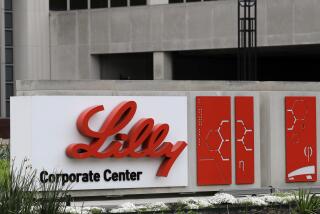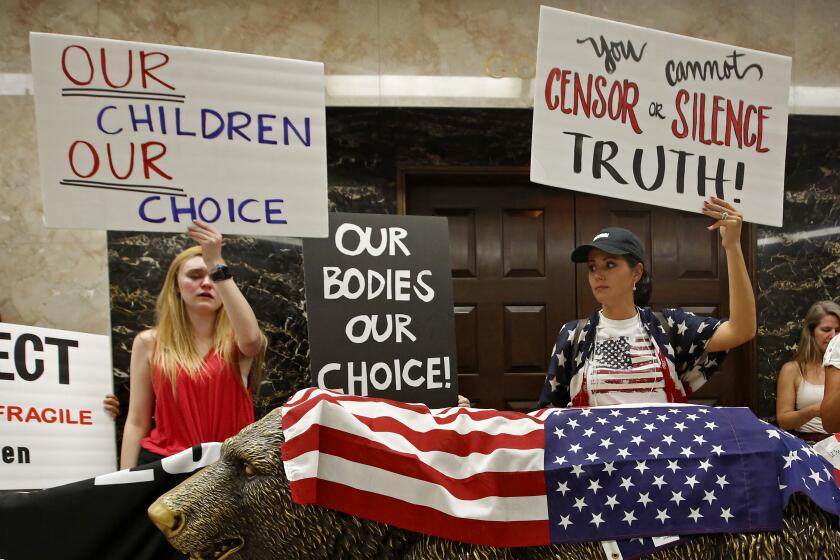Generic drugs’ hidden downside
- Share via
IT’S A DRAG when you suffer from depression. And it’s really a drag when the medication you’ve been treating your depression with effectively for years suddenly leaves you feeling anxious, nauseated or even suicidal. Even more of a drag? When you realize those symptoms began when you switched from your brand-name antidepressant to its generic version. But it’s downright depressing when
your doctor, pharmacist and health insurance provider insist that you’re wrong, that there is no difference between brand-name drugs and their generics, and that these side effects you’re experiencing must be in your head. You are, after all, “mentally ill.”
Yet the true insanity lies in the way many medical professionals, convinced by the FDA, keep pushing the myth that “generic drugs are identical to their brand-name counterparts.” Assurances of total sameness “in dosage form, safety, strength, route of administration, quality, performance and intended use” pop up all over the FDA’s website and are dutifully reprinted on the sites of health insurers, drug makers, pharmacies and others whose interests it serves.
Health insurers, for instance, save so much on generics that a number of them actually offer incentives to doctors and pharmacists to switch their patients off brand-name drugs; earlier this year, Blue Care Network of Michigan was paying $100 per case. Even more widespread: insurers’ practice of charging lower co-pays for generics. Many insurers won’t cover brand-name drugs at all if there’s a generic available. To be sure, consumers benefit financially as well. With an average price of $102 to fill a brand-name prescription -- compared to $29 for a generic one -- generic drugs make medication vastly more affordable.
But how advantageous is it to save $70 a month if taking a generic makes you feel like crap?
I wrestled with this question a few months ago when my doctor prescribed Sertraline, a Zoloft generic, to treat my depression. I’d done well on Zoloft in the past and had seemed to do all right when I was switched to a generic, but I’d only taken it for a few months before I went off the medication entirely. This time, after a month, Sertraline hadn’t made a dent in my symptoms. My generics-happy insurer wouldn’t cover Zoloft, so I contemplated paying the additional cost myself. And I did some research.
It turns out that hundreds of former Wellbutrin XL 300 users were facing a similar dilemma -- although under far graver conditions. The FDA-approved generic, Budeprion XL 300, had arrived on the market last December, and in the weeks and months that followed, complaints began to appear all over Internet health boards. Users who’d been successfully treated with Wellbutrin for years said that they’d been switched to Budeprion by their doctor or pharmacist, often without being informed, and had suffered such consequences as a return of depression (sometimes more severe than ever), suicidal thoughts, panic attacks, mood swings, anxiety, nausea and insomnia. Those who then went back on the brand-name medication reported that their symptoms disappeared.
Veteran syndicated health columnists Joe Graedon, who holds a master’s degree in pharmacology, and his wife, Terry, who earned her doctorate in medical anthropology, were so alarmed by the unprecedented volume of reader response on their website, peoplespharmacy.com, that they notified the FDA. The FDA, in October, confirmed that it was investigating but has yet to issue a comment or findings.
The Graedons also contacted ConsumerLab.com, an independent testing organization. Budeprion users probably found bittersweet consolation in the lab’s analysis of the little yellow pills. It discovered that “generic bupropion XL released its ingredient at a very different rate than Wellbutrin XL.” While the extended-release feature is meant to keep a steady supply of medication flowing to the bloodstream throughout the day, the generic pill released 34% of its ingredients in the first two hours, compared to the brand-name’s 8%. Although both pills started out with equal amounts of active ingredient (bupropion), according to the ConsumerLab report, the large upfront dose from the generic could account for the anxiety, irritability and nausea -- all known side effects of too high a dose of bupropion.
The FDA finds it acceptable for generics to use different time-release technology than their brand-name counterparts. Although the rate and extent of absorption must be similar enough to be deemed “medically insignificant,” lab data and/or test results from a small group (typically 24 to 36 people) of healthy volunteers (typically male) -- provided by the manufacturer -- are considered sufficient to demonstrate this. Clinical testing -- multiphase studies done on thousands of patients to determine safety and effectiveness, which brand-name drugs undergo -- is not required for generics. The assumption is that the innovator drug was already thoroughly tested on humans, so if the generic can be shown to perform “in the same manner” in the lab, then it will perform similarly in patients.
Yet, although generics must have the same active ingredients as the brand-name product, they can include any number of different inactive ingredients (colorings, flavorings, binders, diluents, fillers, etc.) that can cause differences in how well a particular patient absorbs and tolerates a particular medication -- especially patients with allergies, sensitivities or gastrointestinal disease. Formulas also vary from one generic manufacturer to the next. So someone who has success with, say, Company X’s Zoloft generic may have trouble if his or her pharmacist refills a prescription with Company Y’s version. Which is what happened to me. Once I’d made the rounds of neighborhood pharmacies and found one that carried my old generic brand, my symptoms improved.
For the majority of generic drugs, the abbreviated approval process and FDA-sanctioned differences don’t present a significant problem. But the success of those generics doesn’t justify the FDA’s loud and persistent denial of problems with others -- Ambien, Klonopin, Ritalin, OxyContin, Vicodin, Valium, Toprol, Synthroid and Dilantin, to name a handful.
At the moment, this appears to be a situation that’s about to get worse before it gets better. In fiscal year 2007, the FDA approved a record 682 generic drug products, 30% more than in 2006. And in October, it launched the Generic Initiative for Value and Efficiency (with the cute acronym GIVE), which aims to boost approvals further.
The solution, however, isn’t to do away with generics, or to make their approval process as rigorous as that of innovator drugs -- that would only drive up costs and defeat the purpose of having generic drugs at all. The FDA should simply ‘fess up about the differences that can exist between generics and brand-name drugs and acknowledge the potential repercussions. The agency should take a little initiative and educate physicians and pharmacists about the differences. And then it’s up to the white coats -- doctors and pharmacists -- to spend an extra 68 seconds with their patients to explain that there are, in fact, differences between brand-name and generics, and between generics and generics.
Finally, the FDA would do well to be a bit less dismissive of consumer complaints. After all, just because people who rely on antidepressants may have a mental illness doesn’t mean we’re crazy.






